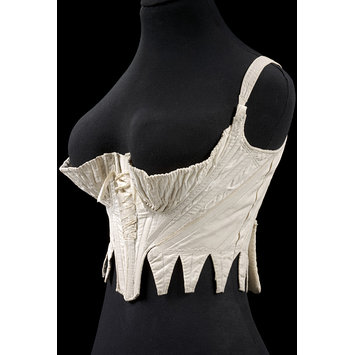I have wanted to make one of these costumes for some time, the craziness of the transitional period from Eighteenth Century to Regency styles as well as the surrounding history fascinates me. In the 1790's partly due to the influence of Neo-classicism which idolised the styles of the ancient Greeks and Romans and also due to the effects of the French Revolution clothing began to become much simpler and less structured. The executions of the French aristocracy in the late 1780's had led to the casting off off the previous rococo styles in order to avoid being targeted for being sympathetic to the monarchy and to show allegiance to the new republic. (This is despite the fact that Marie Antoinette was instrumental in the adoption of the classical style but I'm hoping to cover that in a future post).
tirical Print Ah! Quelle antiquité!!! Oh! Quelle folie que la nouveauté … by Alexis Chataignier (1797) This shows the dramatic change in fashionable dress |
As the waistline of women's dress rose ever higher the waistline of the stays rose with them. The tabs which had flared out from the waistline in order to support the weight of the voluminous skirts were now useless, and in some cases done away with all together.
 |
| A pair of 1780's stays from the V and A |
 |
| A pair of short stays also from the V and A 1795-1805 |
Petticoats began to have bodices or shoulder straps in order to keep them from falling down and they (as well as some pairs of stays and gowns) began to have little cushion pads sewn into the centre back of the waistline in order to stop the gathered skirts from collapsing into the small of the back.
 |
| An early 19th century bodiced petticoat from the Met |
 |
| This pattern for some 1790's stays from N. Waugh's 'Corsets and Crinolines' (1954) shows a pair of stays with round balls of padding to hold out the skirts. |
For my own stays I decided to use the pattern for the late 1790's short stays from 'Regency Women's Dress' by Cassidy Percoco. My reasoning for choosing this pattern was mainly due to the front lacing, though the lack of tabs at the waistline definitely also played a part! As I had to add a relatively large amount to the original pattern in order for it to fit me I decided to split the front panel in two in order to space out the additional fabric. I also decided to forego the straps as I find them extremely difficult to fit properly on myself.
I made a mock-up and after a few further adjustments I was ready to cut out my stays.
For these stays I used a plain cotton canvas (not unlike the linen canvas that was popular at the time). I also used a layer of plain white cotton fabric for the second layer. I drew the boning channels onto the white cotton with a sharp pencil as I wanted them to be as accurate as possible(and they are going to get covered with a linen lining later).
I stitched the boning channels and the main construction seams using a sewing machine.
The decided to use reed boning as I had a lot of it left over from my 1770's stays. I really like how lightweight it is compared to metal boning. One day I want to try synthetic whalebone but my job is seasonal and doesn't exist in January so I was budgeting.
One of the great things about sewing with reed boning is how easy it is to cut down to size. If you stitch a boning channel slightly too small then you can just shave a bit off the reed instead of having to re-stitch an entire channel!
 |
| ready to cut out the canvas |
 |
| The stays prior to adding the boning, vaguely resembling the bat-signal |
The decided to use reed boning as I had a lot of it left over from my 1770's stays. I really like how lightweight it is compared to metal boning. One day I want to try synthetic whalebone but my job is seasonal and doesn't exist in January so I was budgeting.
(editing Isabel from September 2020 who so far hasn't done a day of work all year: 😬)
Once the boning was in I flat-felled the seams whilst watching the 1995 Pride and Prejudice. For the binding and seam coverings I decided to use leather which was historically used very often for this purpose. It was the first time I had tried this technique and I found the chamois leather surprisingly easy to work with.
After the binding was stitched on I cut out a lining from some linen and hand stitched it in. I decided to hand stitch the eyelets as well and found that using a knitting needle to force apart the hole was very successful, compared to my 1770s stays were I found that the eyelets were a little too small.
After this the stays were complete. They fit me well and are very comfy and I really like the simplicity of the plain canvas fabric. The front opening is also makes dressing myself much quicker and easier and I think any stays are make in the future will probably all have front lacing for as long as it is historically accurate!
For the next layer of underpinnings I made a linen petticoat using the pattern and instructions from 'The American Duchess Guide to Eighteenth Century Dressmaking'. It was completely hand stitched and I found it incredibly enjoyable to put together.










No comments:
Post a Comment